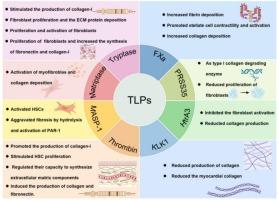胰蛋白酶样蛋白酶:纤维化的新视角。
IF 5.1
2区 医学
Q1 MEDICINE, RESEARCH & EXPERIMENTAL
引用次数: 0
摘要
纤维化作为一种慢性疾病,正在影响着人们的健康。主要的病理特征是纤维结缔组织的沉积,如胶原和纤维连接蛋白,它们是细胞外基质(ECM)的组成部分。如果不及时治疗,纤维化会导致永久性疤痕、器官功能障碍,最终导致死亡。最近的报道表明,纤维化可能是可逆的。因此,寻找潜在的基因靶点或生物标志物进行抗纤维化治疗具有相当重要的意义。胰蛋白酶样蛋白酶(Trypsin-like proteases, TLPs)是一类主要针对P1位赖氨酸和精氨酸等碱性残基的丝氨酸酶,广泛分布于体内。TLPs在消化、血液凝固、伤口愈合和免疫等多种生理过程中发挥重要作用。它们可以通过切割和激活PARs受体或在纤维化疾病期间直接水解胶原来促进成纤维细胞的增殖、分化和活化,以及胶原蛋白的产生。本文旨在通过近年来的研究阐明TLPs与纤维化疾病之间的联系。越来越多的人认为,TLPs在各种纤维化疾病中发挥着潜在的治疗靶点。本文章由计算机程序翻译,如有差异,请以英文原文为准。

Tryptase-like proteases: A novel perspective for fibrosis
Fibrosis, as a chronic disease, is affecting people's health. The main pathological characteristic is the deposition of fibrous connective tissue, such as collagen and fibronectin, which are components of the extracellular matrix (ECM). When fibrosis is not treated in time, it can lead to permanent scarring, organ dysfunction, and eventually death. Recent reports indicated that fibrosis may be reversible. Therefore, it is considerable significance to find potential gene targets or biomarkers for anti-fibrosis treatment. Trypsin-like proteases (TLPs), a family of serine enzymes predominantly specific for basic residues such as lysine and arginine in the P1 position, are widely distributed in the body. TLPs play crucial role in various physiological processes, including digestion, blood coagulation, wound healing, and immunity. They could promote the proliferation, differentiation, and activation of fibroblasts, as well as collagen production, either by cleaving and activating PARs receptors or by directly hydrolyzing collagen during fibrotic diseases. This review aims to clarify the connection between TLPs and fibrotic diseases through recent studies. There is an increasing agreement that TLPs play a potential therapeutic target for various fibrotic conditions.
求助全文
通过发布文献求助,成功后即可免费获取论文全文。
去求助
来源期刊

Life sciences
医学-药学
CiteScore
12.20
自引率
1.60%
发文量
841
审稿时长
6 months
期刊介绍:
Life Sciences is an international journal publishing articles that emphasize the molecular, cellular, and functional basis of therapy. The journal emphasizes the understanding of mechanism that is relevant to all aspects of human disease and translation to patients. All articles are rigorously reviewed.
The Journal favors publication of full-length papers where modern scientific technologies are used to explain molecular, cellular and physiological mechanisms. Articles that merely report observations are rarely accepted. Recommendations from the Declaration of Helsinki or NIH guidelines for care and use of laboratory animals must be adhered to. Articles should be written at a level accessible to readers who are non-specialists in the topic of the article themselves, but who are interested in the research. The Journal welcomes reviews on topics of wide interest to investigators in the life sciences. We particularly encourage submission of brief, focused reviews containing high-quality artwork and require the use of mechanistic summary diagrams.
 求助内容:
求助内容: 应助结果提醒方式:
应助结果提醒方式:


